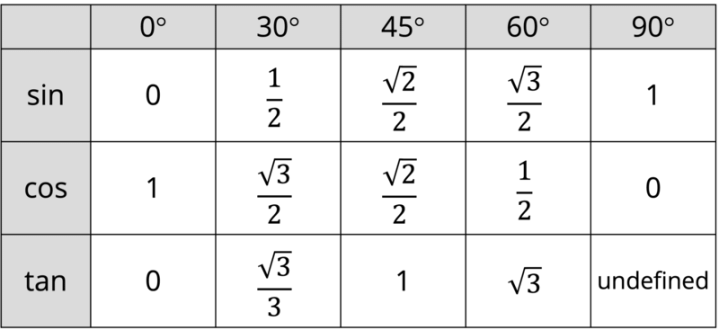Class 10 Exam > Class 10 Notes > Mathematics for GCSE/IGCSE > Exact Trig Values
Exact Trig Values | Mathematics for GCSE/IGCSE - Class 10 PDF Download
What are exact values in trigonometry?
- Exact values in trigonometry refer to specific values of sine, cosine, and tangent for certain angles that can be expressed precisely using fractions and surds.
- You should be able to recognize and derive these values geometrically.
- It is essential to know the exact values for angles of 0°, 30°, 45°, 60°, 90°, 180°, and their multiples.
- The exact values you are expected to know are summarised here:

- Note that the values of sin θ going from 0° to 90° match those of cos θ going from 90° to 0°
How are exact values in trigonometry derived?
There are two special right-angled triangles that provide exact values for trigonometric functions.
- Consider a right-angled triangle with a hypotenuse of 2 units and a shorter side length of 1 unit. Applying Pythagoras’ theorem, the third side will be √3 units. The angles are 90°, 60°, and 30°. Utilizing SOHCAHTOA:
- Sin 60° = √3/2, Sin 30° = 1/2
- Cos 60° = 1/2, Cos 30° = √3/2
- Tan 60° = √3, Tan 30° = (√3)/3
- Now, consider an isosceles triangle with two equal side lengths (the opposite and adjacent) of 1 unit. Applying Pythagoras’ theorem, its hypotenuse will be √2 units. The two equal angles are 45°. Applying SOHCAHTOA:
- Sin 45° = 1/√2 = √2/2
- Cos 45° = 1/√2 = √2/2
- Tan 45° = 1

The document Exact Trig Values | Mathematics for GCSE/IGCSE - Class 10 is a part of the Class 10 Course Mathematics for GCSE/IGCSE.
All you need of Class 10 at this link: Class 10
|
42 videos|395 docs|19 tests
|
FAQs on Exact Trig Values - Mathematics for GCSE/IGCSE - Class 10
| 1. What are exact values in trigonometry? |  |
Ans. Exact values in trigonometry refer to the trigonometric ratios of certain angles that can be expressed as simple, exact numerical values without the use of a calculator.
| 2. How are exact values in trigonometry derived? |  |
Ans. Exact values in trigonometry are derived using special right triangles, unit circle definitions, and trigonometric identities to find the exact values of sine, cosine, and tangent of common angles such as 30°, 45°, and 60°.
| 3. Why are exact values important in trigonometry? |  |
Ans. Exact values in trigonometry are important because they allow for precise calculations and simplification of trigonometric expressions without rounding errors that can occur when using approximate values from a calculator.
| 4. What are some common exact trigonometric values used in trigonometry? |  |
Ans. Some common exact trigonometric values used in trigonometry include sin(30°) = 1/2, cos(45°) = √2/2, tan(60°) = √3, and their respective reciprocal values.
| 5. How can exact trigonometric values be applied in real-world scenarios? |  |
Ans. Exact trigonometric values can be applied in real-world scenarios such as engineering, physics, and geometry to calculate angles, distances, heights, and other measurements accurately without the need for approximation.
Related Searches















